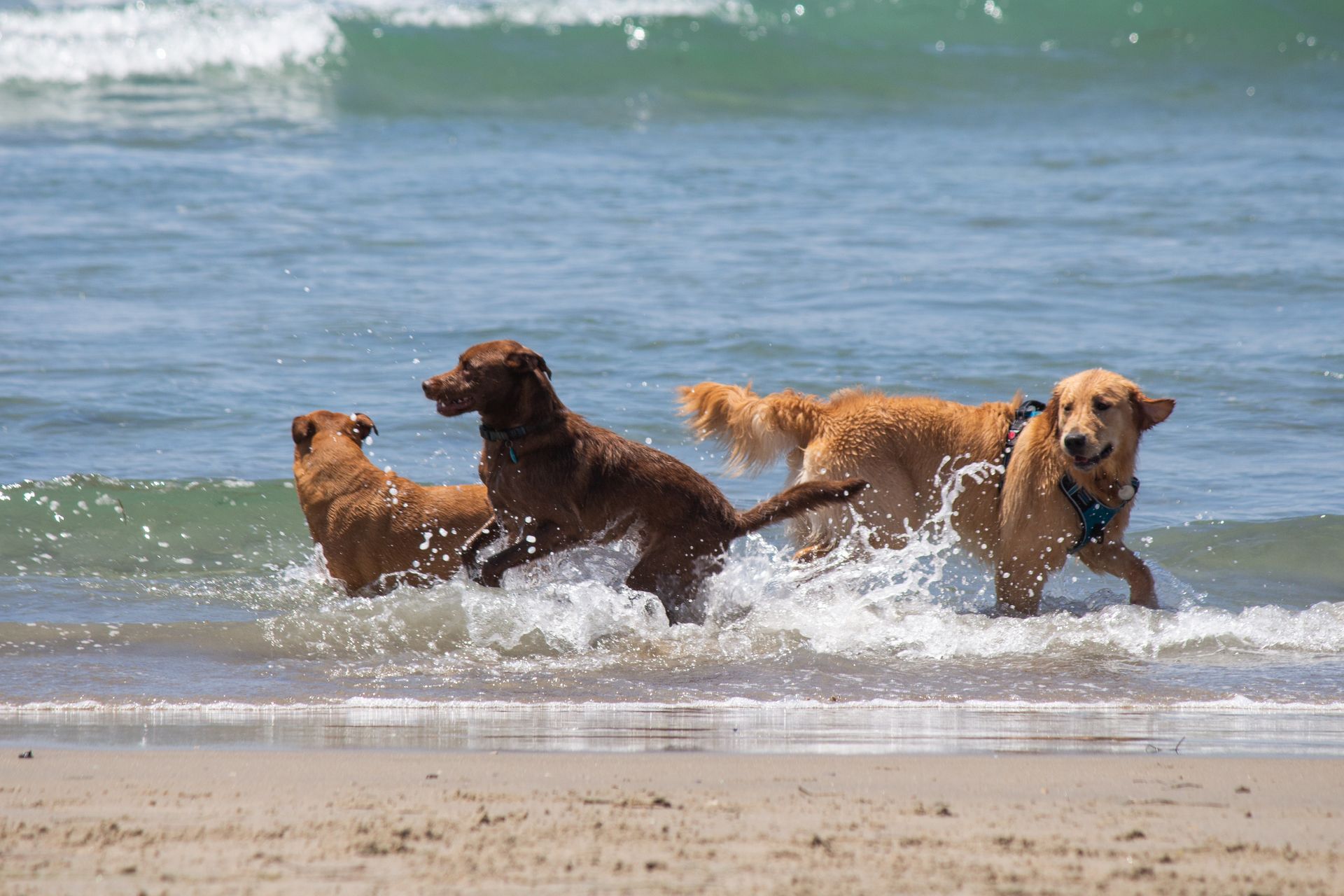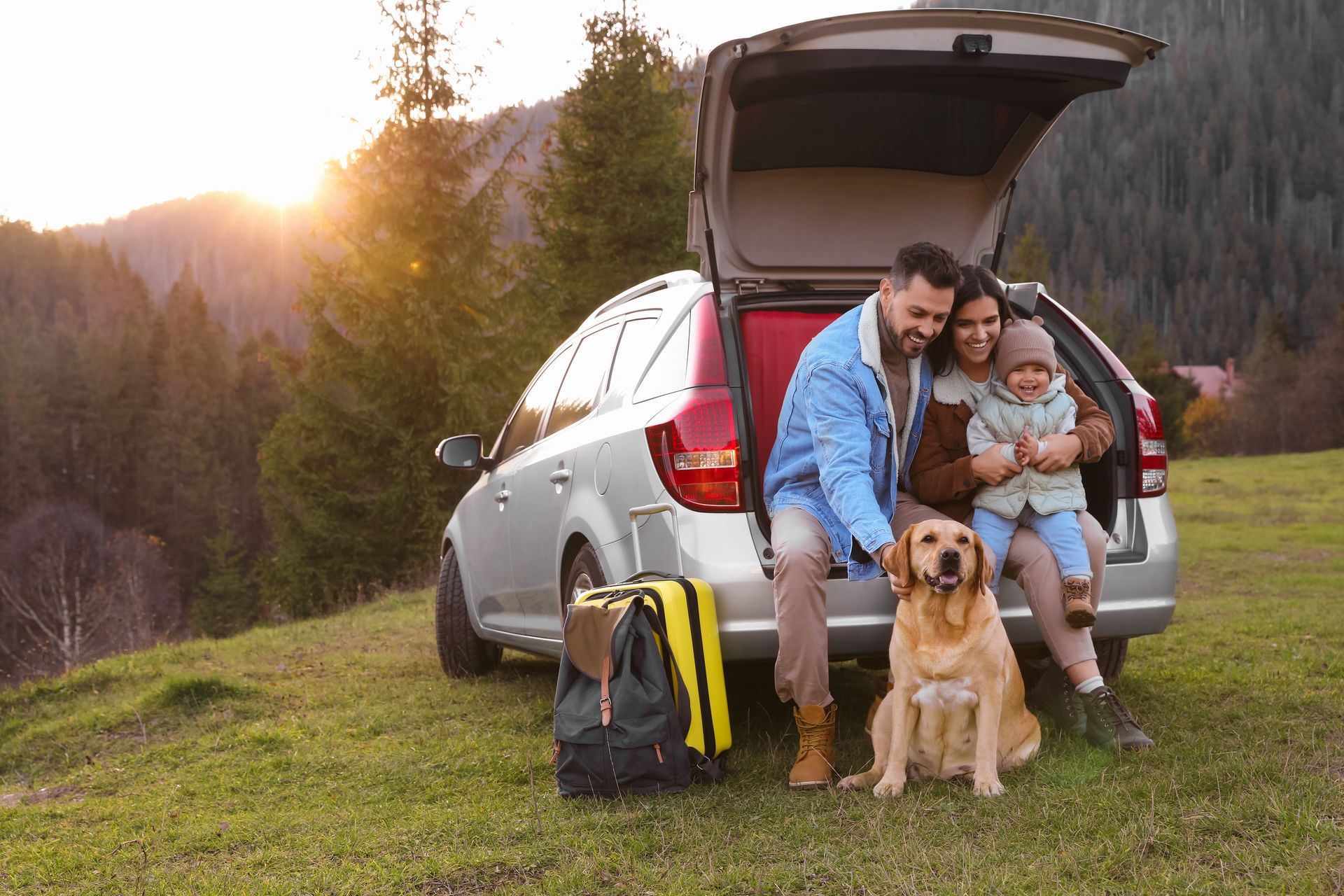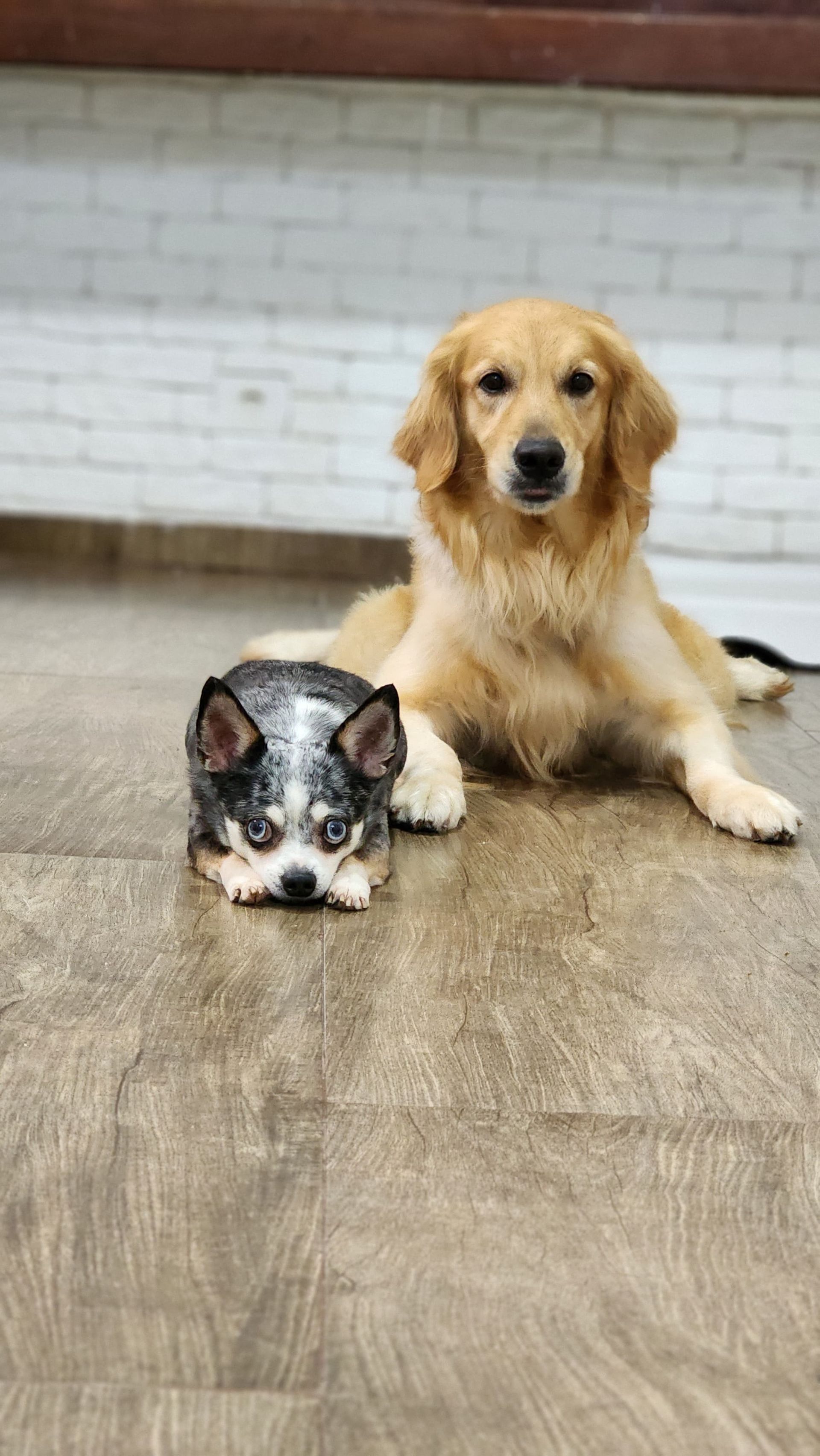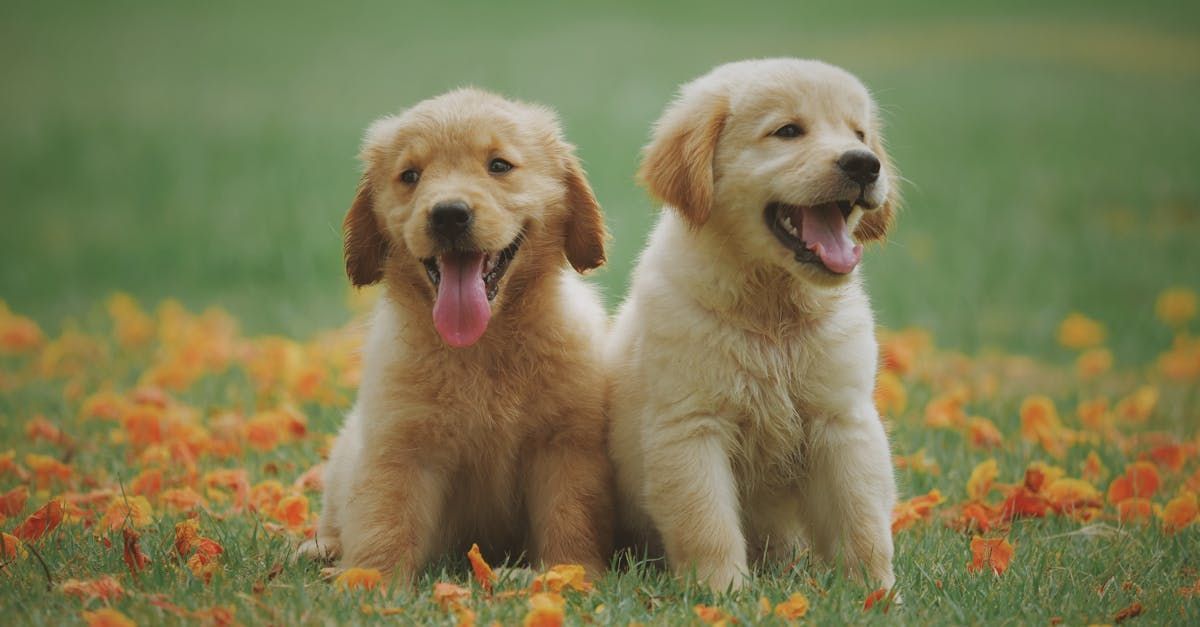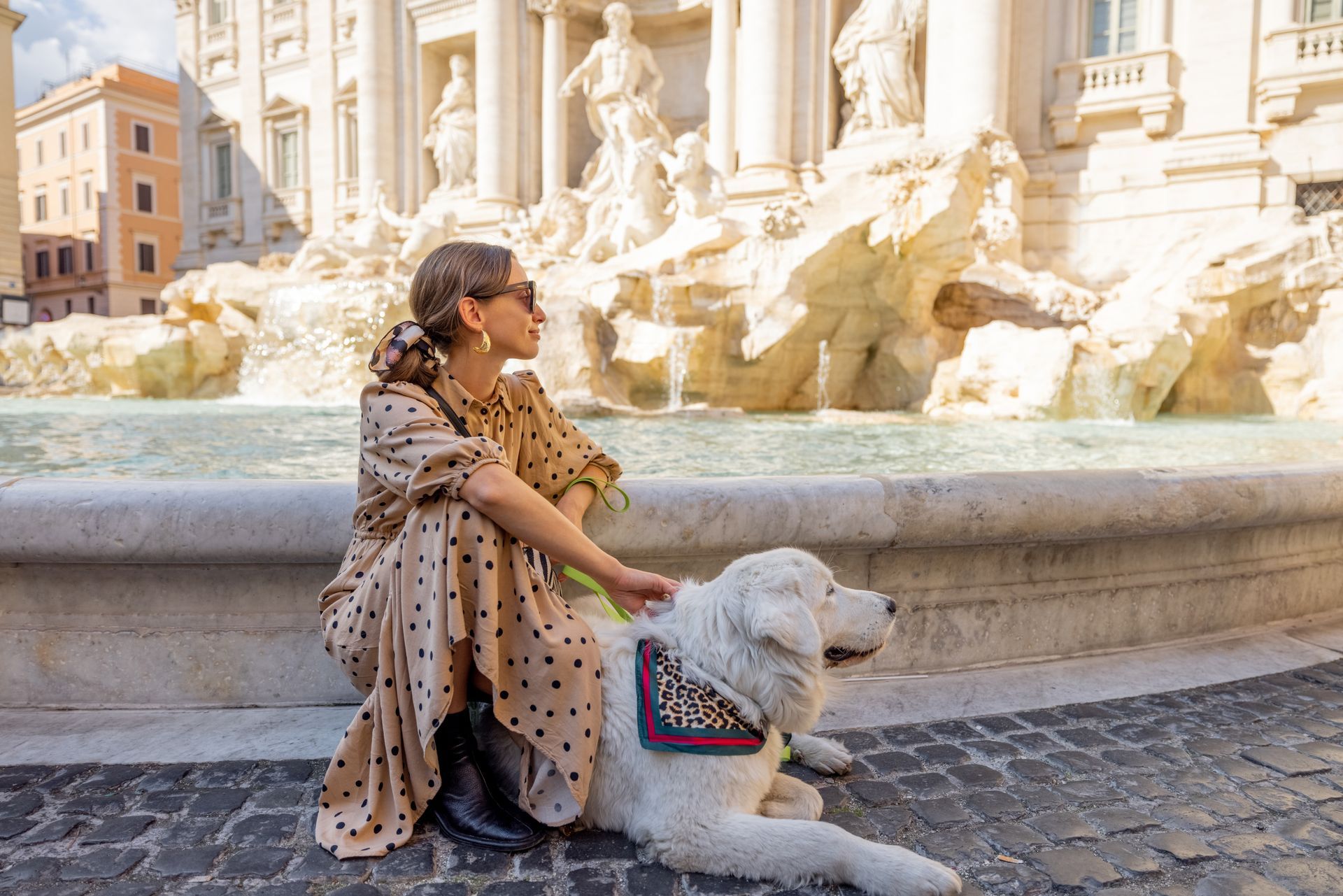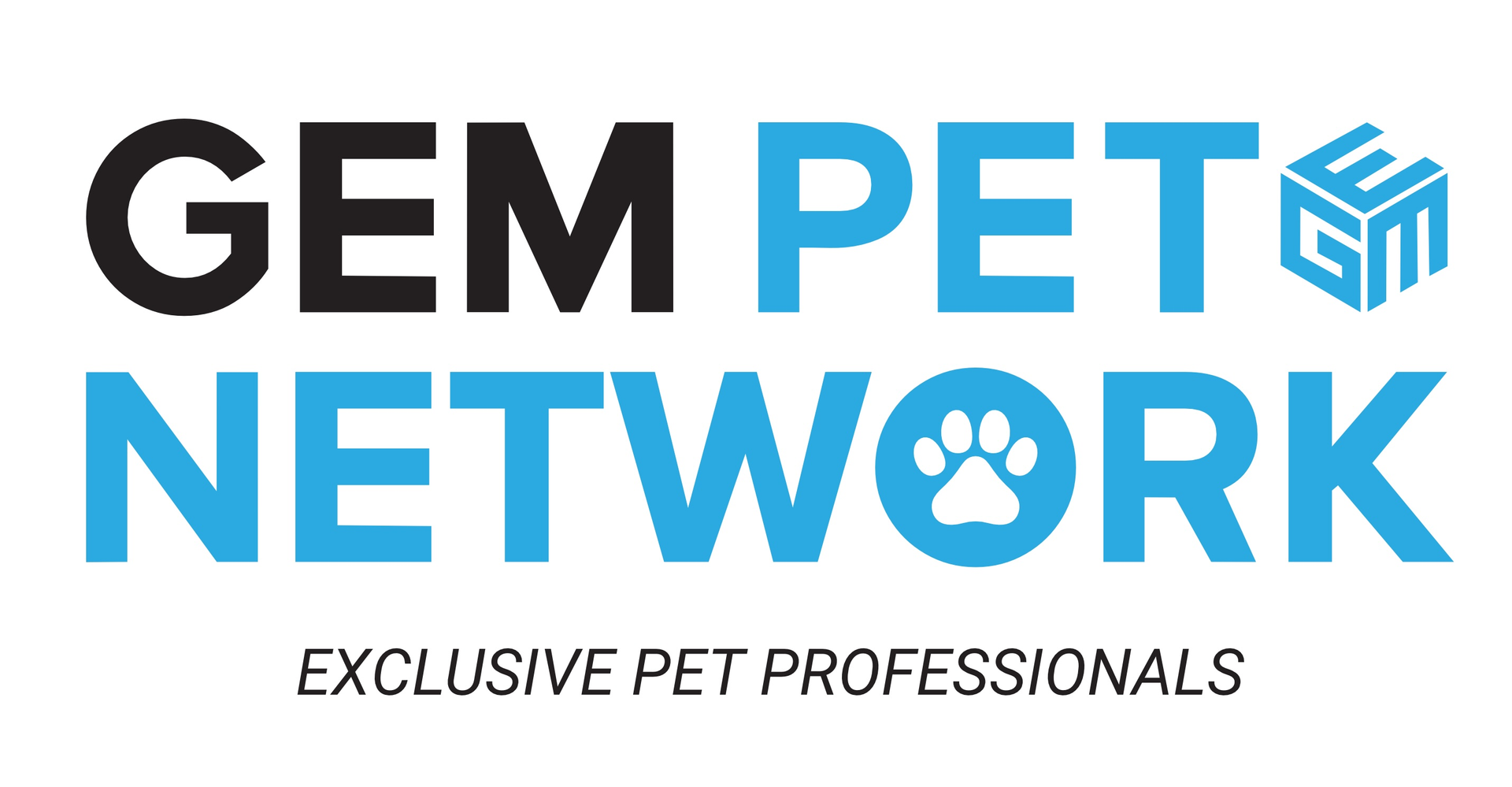Dog Behavior
Have you ever asked the question, why does my dog eat grass or chase his tail? Some dogs display some funny behaviors that we often wonder what the cause is. We answered just a few top questions that people ask about dogs.
WHY DOES MY DOG EAT GRASS?
If you Google "Why do dogs eat grass" you will find a zillon websites that all seem to have their theory. I glanced at about two dozen of these and every one of them mentioned eating grass to deal with an upset stomach and to cause vomiting. I have personally never found this explanation to be particularly satisfying because the cause and effect issues are all tangled up in it - "Do dogs eat grass to make themselves vomit, or do they vomit because they ate grass?" The other issue is that many dogs eat grass and don't end up vomiting. My Border Collie, Panda, eats grass daily during her park outing, and she almost never vomits.
The second most popular answer is that dogs evolved from wild canines, such as wolves, who hunt and eat mostly grass eating animals like mice, rabbits, or deer. When these canines consume their prey they will usually eat pretty much all of it, including the grass filled stomach of whichever creature they just killed. It's also mentioned that grass eating may have evolved to help conceal their scent from their prey.
LET'S PUT IT TO THE SCIENTIFIC TEST:
There have been a series of surveys that were designed to test the hypotheses that most plant eating in dogs is associated with illness and results in vomiting, or that grass eating is associated with some kind of dietary deficiency.
The initial study was a survey of 25 veterinary students who had pet dogs. All of the students reported that their dogs ate grass.
None reported seeing any signs of illness before their dogs ate the grass and only 8% said that their dogs regularly vomited after eating it.
The researchers then conducted a second survey which involved 47 dog owners who had brought their pets to the UC Davis teaching hospital for outpatient care. This group reinforced the fact that grass eating was quite common since 79% had observed their dogs eating plants (mostly grass). When questioned about their dog's behavior before and after eating grass it was found that signs of illness were infrequent (only four dogs) and vomiting afterward was also not common (only six dogs).
After these two preliminary studies the researchers expanded their data sample by conducting a large web-based survey which netted 1,571 usable data sets from dog owners. Once again it was found that grass eating was common since 68% of the respondents said their dogs ate grass on a daily or weekly basis. Only 8% reported that their dogs frequently showed signs of illness before eating grass and 22% reported that their dogs regularly vomited afterwards. In the grass eating dog population they found that it was the younger dogs who ate grass most frequently and they were less likely to appear sick before or to vomit afterwards. The research did find, however, that if a dog showed signs of illness before eating grass it was more likely to vomit afterwards.
As for the notion that dogs are eating grass in order to make up for some kind of dietary deficiency no support was found. Dogs that had their diet regularly supplemented by plant matter (vegetables or fruit) were no less likely to eat grass which seems to kill the idea that dogs are eating grass to make up for the absence of vegetable matter in their normal food intake.
The researchers conclude that grass eating is a common behavior that usually occurs in normal dogs and is generally not associated with illness or dietary needs. They go on to suggest that grass eating may reflect an innate predisposition inherited from dogs' wild ancestors. This is supported by research on droppings left by wolves. Such research finds evidence of grass in 11 to 47% of the stool samples studied. The usefulness of grass eating in these wild canines is that it can help to purge intestinal parasites. The plant material passes through the intestinal tract and the fibrous matter increases the intestinal contractions and wraps around the worms or nematodes which may be infecting the animal. In this way the grass helps to purge the system of these potentially harmful parasites. Although most pet dogs are free of such worms they nonetheless may still have that predisposition to eat grass which was helpful to their ancestors living in the wild.
An alternate suggestion, and what I tend to think, is that dogs may eat grass simply because they like the taste of it.
DO DOGS DREAM?
You've probably seen it happen - your sleeping dog suddenly lets out a woof as his legs begin to twitch. Is he dreaming?
Many scientists say there is evidence to support the idea that dogs do, in fact, experience dreams. Researchers using an electroencephalogram (EEG) have tested canine brain wave activity during sleep. They've found that dogs are similar to humans when it comes to sleep patterns and brain wave activity. Like humans, dogs enter a deep sleep stage during which their breathing becomes more irregular and they have rapid eye movements (REM). It is during REM sleep that actual dreaming and, often, involuntary movements take place. Dogs may move their legs as if they are running, whine or whimper as if excited, and breathe rapidly or hold their breath for short periods.
Not all dogs dream equally. Research suggests that small dogs dream more than larger dogs. A Toy Poodle may dream once every ten minutes while a Golden Retriever may only dream once every 90 minutes. Dreaming also seems to occur more frequently in puppies. This may be because they are processing huge quantities of newly acquired experiences.
What do dogs dream about? Since no dog has ever told anyone about a dream he's had, we can only guess. It's likely that dogs dream in a similar fashion to humans, replaying the everyday activities that make up their existence, like chasing, playing, and eating.
If you've ever been tempted to wake your dog during a dream, try and resist. It's best to "let sleeping dogs lie." Dogs, like humans, need uninterrupted sleep for healthy mental activity.
WHY DO DOGS HOWL?
You've probably been here before: you're leading your dog around the neighborhood on a typical pack walk when suddenly there's a siren way off in the distance. You barely notice it, but your dog's ears immediately perk up. As it gets closer and closer (and louder and louder), she becomes more and more agitated or excited. Finally, it rounds the corner, headed your way, and as it nears you and passes by, your pooch lets loose with a glorious howl, head thrown back like she was a wolf out in the desert.
What's going on here? Why do dogs howl? There are a number of reasons. Some that are no big deal, and others that should be addressed.
Ancestry
Think your dog sounds like a howling wolf? That's probably because dogs are distantly related to wolves, and the urge to howl is still embedded in their genetic code. Sometimes they don't even know why they're doing it, just that it's what they're supposed to be doing. Howling is totally normal and natural as long as it's not chronic, pervasive, or invasive.
Communication
In the wild, wolves howl to tell a lost member of their pack where they are or to ward off another animal that's encroaching on their territory. For domesticated dogs, this may translate to howling at sirens ("Hey, I'm over here!"), howling when a strange dog comes near ("Too close, buddy!"), or both.
Howling like the above two examples should be expected and isn't anything to worry about as long as it isn't accompanied by aggression toward other dogs or people. Most dog owners even tend to find it pretty cute. However, there are situations where howling is a symptom of something deeper that needs to be fixed.
Sickness and injury
One of the ways that many dogs express the fact that they are hurt or sick is by howling or vocalizing in other ways. If you notice that your dog is making strange sounds or "talking more than normal, get them to the vet for a check-up.
Separation anxiety
Remember how wolves howl to find each other in the wild? Well, if your dog is suffering from separation anxiety, it's possible that he'll start doing this every time you leave - not fun for you, the dog, or your neighbors.
How do you know that the howling is being caused by separation anxiety ? Because it's usually accompanied by another symptom, such as destroying things, pacing around, or eliminating inside the house. Howling of this kind will take time and consistent effort to overcome.
WHY DO DOGS HAVE WHISKERS?
Dog whiskers are found on both sides of their muzzle, as well as on the forehead above the eyes, on their chin and above the upper lip. As puppies grow, the whiskers are among the first hairs to develop. Unlike the neatly arranged 12 whiskers in four rows on each side of a cat's face, dog whiskers are more varied in their pattern depending on their breed and genetics.
Whiskers are twice as thick and coarser than regular dog hair. Their roots are set three times deeper and packed with nerves and blood vessels that make each individual whisker a super sensitive receptor to movement. Air moving it or objects brushing against it causes the whisker to vibrate and stimulates the nerves. Dog whiskers are as sensitive as our fingertips. Whiskers play an important role in helping dogs understand and move through their environment.
The primary function of whiskers is to aid a dog's vision, and they are often referred to as tactile hair. Whiskers pick up the slightest vibrations in the air, as well as subtle shifts in wind direction and speed. This alerts dogs to the presence of prey or other objects close by and tells them size, shape and if there's any motion. Whiskers are why a dog can hunt in the dark and keep from crashing into furniture, falling down steps or bumping into walls as he walks around the house at night. Moving air currents cause the whiskers to vibrate and alert a dog to an obstacle or prey. When a dog is approaching something in his path, air is stirred up as he moves. When the air hits a wall, other surfaces or another animal, it bounces back and is picked up by the dog's radar-like whiskers.
The vibrissae are also handy for finding small objects. Dog eyes can't focus on objects up close, so information gathered from his whiskers helps him find, identify and pick up something that's right under his nose.
Whiskers help dogs know if they can fit through a narrow opening or not. They are sensory receptors that help canines navigate. Dogs bred to go to ground need to know if a hole is big enough for them to crawl through. These receptors also give him information about obstacles that may be in the way and they also send information about the shape and size of a critter hiding in a den. Whiskers also help protect the face and eyes. When a dog brushes his whiskers against dirt, tall grass or anything else, it causes him to blink his eyes and avoid injury. The whiskers above his eyes lets him know if he's too close to something and helps to keep him from getting poked in the eye.
Every now and then you might find a whisker that's fallen out. It will grow back, but you should never try to pull a whisker out.
You might run across a groomer who wants to cut your dog's whiskers. However, it's best not to trim the whiskers because that makes it more difficult for a dog to feel around his face and move with confidence. Because whiskers are very sensitive, pulling on them will cause your pet discomfort and stress. The importance of the whiskers is easier to understand when you consider the areas of the brain devoted to touch information. Almost 40% of those areas are dedicated to the regions where the whiskers are located. In fact, each individual whisker can be traced back to a specific location in the brain.
Think about your dog's whiskers as tiny radar detectors that are so finely tuned they can help him detect a rabbit hiding under a bush or keep him from running face first into a wall. The superior hunting ability of canines is one reason why the human/dog partnership has been so successful, and his whiskers help him do the job he was bred to do.
WHY DO DOGS CHASE THEIR TAILS?
Researchers found that variations on canine behavior in certain breeds may be down to where the dogs lived, their diet and their general upbringing.
Many well-known faces suffer from OCD to varying degrees.
David Beckham, for instance, cannot stand odd numbers of items in his fridge so if he has three cans of drink he will throw one out, according to an interview with wife Victoria.
Leonardo DiCaprio says he has to force himself not to step on every chewing gum stain on the pavement because he doesn't want his condition taking over his life. Genetics researchers from the University of Helsinki examined OCD among 400 dogs.
Breeds such as Bull Terriers and German Shepherds were particularly prone to chasing their tails, which led the researchers to believe genetics plays a role.
But then they noticed other connections. Dogs which were fed nutritional supplements like vitamins were less likely to chase their own tails, which suggested diet plays a part.
Dogs that were separated particularly early from their mother or had poor care from their mother also exhibited OCD-style signs of behavior. However the researchers found that a lack of exercise did not make any difference with tail-chasing.
Dogs most likely to chase their own tails were, generally, more timid and more afraid of loud noises. Different environmental and genetic factors have been suggested to predispose to compulsive behavior. Many stereotypes are breed-specific, which emphasizes the role of genes.
Here are a few reasons that dogs may chase their own tail:
- Being confined in small quarters where movement is restricted
- Boredom, especially in older dogs
- The presence of fleas or irritated anal glands
- Canine compulsive disorder, which although rare, can be treated with anti-obsessive medications such as Prozac.
- Hereditary tendency, with the behavior being passed down from generations, especially in some breeds including German Shepherds, Australian Cattle Dogs and Bull Terriers
- High cholesterol, which as suggested by veterinarian Marty Becker, could mean that the dog's cholesterol levels have blocked the flow of brain hormones, which control mood and behavior. (More exercise could be the solution in this case.)
- Not knowing why the tail is there to begin with! This part of a puppy's body is fascinating to him, especially if he has no other playmates
HOW DO I INTRODUCE MY DOG TO OTHER DOGS?
Maximizing the potential for a great relationship between your new dog and your current dog is a two-step process. It involves the actual introduction and then management of the new dog in your home. We'll start with introductions and then give you guidelines for helping your dogs through the initial transition weeks of being together in your home.
Introductions
- Leave your current dog at home when you pick up your new dog. One of the worst things you can do is to just throw the two of them together in your car and hope for the best!
- Introduce your dogs on neutral territory, like on a short walk through your neighborhood, in a nearby park or in a friend's yard. Have two people, one to handle each dog, while keeping the dogs on leashes.
- To minimize tension, try to keep the dogs' leashes loose so that they're not choking or feeling pressure on their throats.
- Don't force any interaction between the dogs. If the dogs ignore each other at first, or if one dog seems reluctant to interact with the other, that's okay. Give both dogs time to get comfortable. They'll interact when they're ready.
- Make the introduction positive and light-hearted. As the dogs sniff and get acquainted, encourage them in a happy tone of voice. At first, allow just a few seconds of sniffing. Then gently pull the dogs away from each other and let them walk around with their handlers. After a minute or two, you can lead the dogs back together and allow another several seconds of sniffing. These brief greetings help keep the dogs' interactions calm and prevent escalation to threats or aggression. You can also interrupt their interactions with simple obedience. After a brief sniff, lead the dogs apart, ask them to sit or lie down, and then reward them with treats.
- Closely observe the dogs' body language. Their postures can help you understand what they're feeling and whether things are going well or not. Loose body movements and muscles, relaxed open mouths, and play bows (when a dog puts his elbows on the ground and his hind end in the air are all good signs that the two dogs feel comfortable. Stiff, slow body movements, tensed mouths or teeth-baring, growls and prolonged staring are all signs that a dog feels threatened or aggressive. If you see this type of body language, quickly lead the dogs apart to give them more distance from each other.
Again, practice simple obedience with them individually for treats, and then let them interact again - but this time more briefly. Please see our Canine Body Languagearticle for illustrations of dogs showing what various feelings look like in dog body language. - Once the dogs' greeting behaviors have tapered off and they appear to be tolerating each other without fearful or threatening behavior, you're ready to take them home. Before you take them inside, walk them together around your house or apartment building.
- Be patient. Bringing a new dog home requires that everyone make some adjustments, especially your current pets. And it will take time for your dogs to build a comfortable relationship.
The First Couple of Weeks at Home
- It's crucial to avoid squabbles during the early stages of your dogs' new relationship. Pick up all toys, chews, food bowls and your current dog's favorite items. When dogs are first forming a relationship, these things can cause rivalry. These items can be reintroduced after a couple of weeks, once the dogs have started to develop a good relationship.
- Give each dog his own water and food bowls, bed and toys. For the first few weeks, only give the dogs toys or chews when they're separated in their crates or confinement areas.
- Feed the dogs in completely separate areas. Pick up bowls when feeding time is over. (Some dogs will compete over bowls that recently contained food.)
- Keep the dogs' playtime and interactions brief to avoid overstimulation and overarousal, which can lead to fighting.
- Confine the dogs in separate areas of your home whenever you're away or can't supervise their interactions.
- Give your new dog his own confinement area. When the dogs are separated, it might be a good idea to let them get to know each other through a barrier, like a baby gate. Your new dog should be gated in his confinement area, and your current dog should be free to move around and visit when he wants to.
When the dogs are interacting, interrupt any growling or bullying behavior with a phrase like "Too bad," and then quickly separate them for several minutes. Then allow them to be together again. If your dogs seem to react poorly to each other often, don't hesitate to contact a professional who can help you, such as a Certified Applied Animal Behaviorist (CAAB), a board-certified veterinary behaviorist (Dip ACVB) or a Certified Professional Dog Trainer (CPDT) who's experienced in treating problems between dogs. Please see our article, Finding Professional Help, to locate a professional in your area. - Be sure to sincerely praise your dogs when they are interacting nicely.
- Spend time individually with each dog. Give each of them training time with you and playtime with other dogs outside your home.
- If your dogs are very different in age or energy level, be sure to give the older or less energetic one his own private space where he can enjoy rest and down time.
WHY DO DOGS BURY BONES?
Dog owners have wondered for years why their four legged friends are constantly burying their favorite toys, or even some of the treats you give them. It's an age-old question, with an answer that dates back just as far! Whether your dog is outside digging every chance he gets or just waiting until the right moment, it's nothing to be worried about. It can be annoying - not to mention messy - but it's perfectly normal.
A dog's desire to bury his food and toys is rooted in instinct. Just like his ancestors, your dog is trying to protect and preserve his beloved item. In the wild, dogs and other canids never knew when their next meal was going to come, so they would bury what they didn't finish eating to protect it from scavengers. Later, when they were hungry again, they knew just where to look for an easy snack - in the spot they buried it! Furthermore, burying food often preserved meat and bones and kept them fresh and tasty. With their excellent sense of smell, it's no wonder that dogs can find food they buried deep into the ground days ago.
If you have a dog that just loves to bury his toys and food, he might actually be telling you you're being too generous. Dogs that don't eat their treats, but bury them instead, are exhibiting the exact same behavior their ancestors did - they're saving extra food for later. If you give your dog treats too often, he probably isn't very hungry and plans to return to his snack when he is!
The same goes for toys or other objects. Some dogs are more greedy than others and prefer to keep their prize possessions in a secret location. This location, more often than not, is probably under the dirt in your backyard! It's not unheard of for dogs to collect and bury other items too, such as jewelry and television remotes.
Burying can be quite a nuisance for dog owners, but it's healthy behavior on the dog's part. Some owners have dealt with the issue by teaching their dogs to hide toys under couches or inside blankets. In fact, they've even made games from the need to bury. Not only have they taught the dog where it's appropriate to hide something, they've taught which items are appropriate to hide. It's best not to let your pup bury food, because he might consume it later when it's gone rancid and become sick. So if you've got a dog that's constantly burying items, make sure you aren't giving too many treats or toys, and consider trying to teach your dog to hide his things in an acceptable place in your house.
WHY IS MY DOG'S NOSE WET?
The exact reason for a dog's cold, wet nose is up for debate. Here are a few proposed explanations:
- Housekeeping: A dog's nose gets into everyone's business, not to mention his food dish. He constantly licks his nose to keep it clean, leaving it cool and wet.
- Cooling off: A dog is covered with hair and is unable to sweat through the skin like a person does. Instead, dogs dissipate body heat through their mouths, by panting, and through their wet noses, by evaporation. Special mucous glands inside the dog's nostrils produce the clear, watery fluid that helps speed the cooling process.
- Scent detection: A dog's sense of smell is approximately one million times greater than ours. It's thought that a wet nose helps absorb the tiny water droplets that carry a scent, making the most minuscule odors easier to detect.
Why May a Dog's Nose Sometimes Be Dry?
- A healthy dog's nose is often warm and dry after sleep.
- For some dogs, a dry, chapped nose is normal, especially with age.
- Dehydration or exertion may cause a warm, dry nose.
- Lying in the sun or spending time near a heat source may result in a dry nose.
When Should I Be Concerned About My Dog's Nose?
The temperature of your dog's nose is a poor gauge of overall body temperature. If your dog has a warm nose but is alert and acting normally, he's probably in perfectly good health. However, there are some times when a dog's dry, warm nose could be of concern. If it is associated with any of the following signs, see your veterinarian right away:
- Listlessness.
- Acting painful.
- Poor appetite.
- Redness and/or the flaking skin on or around the nose.
- Presence of nasal discharge.
- Cracked nose or sores and scabs on the nose.
Even if your dog's nose is wet and cool, any of the above signs require a visit to the veterinarian.


